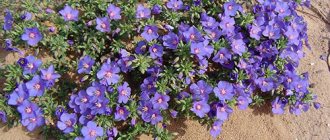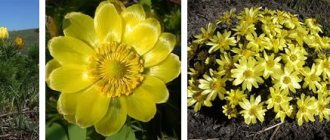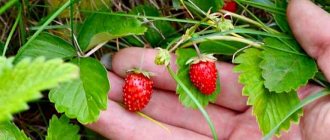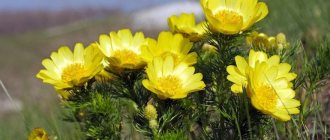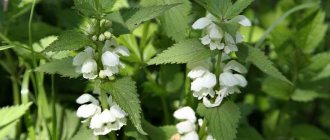Horsetail has many advantages, thanks to which it is actively used in pharmaceuticals and medicine.
In particular, it is used as a strong diuretic, hemostatic, anti-inflammatory, antimicrobial and blood pressure lowering agent.
Through various studies, scientists have found that this unique plant has a strong detoxifying effect. It makes it possible to remove lead from the body. So what is horsetail, its properties and indications for use are described in detail in this article.
What does it look like?
Along with the moss and fern, it is one of the oldest herbaceous plants on the entire planet. The structure of horsetail is a plant with a dark-colored rhizome, from which brown and succulent unbranched stems with a spikelet at the end begin to sprout in the spring.
Photo of horsetail
A little later, on the same root system, soft green, highly branched stems begin to grow, which can reach a length of up to half a meter. The latter are actively used in medicine to treat various diseases.
Medicinal raw materials and their chemical composition
Vegetative shoots of horsetail are harvested in June-August. Cut at a height of 5-10 cm from the soil surface. Dry in the shade in the open air, laying out in a loose layer and turning over periodically.
The finished raw material consists of stems up to 30 cm long, grayish-green in color, hard, straight with branched shoots. The smell is weak, peculiar, the taste is sour. The shelf life of raw materials is 2 years.
As mentioned above, horsetail grass contains silicic acid salts (up to 25%) in water-soluble organic form, small amounts of alkaloids nicotine, equisetin, 3-methoxypyridine, bitterness, saponins, malic acid, mineral salts, tannins, vitamin C, flavonoids.
Beneficial features
The use of horsetail to eliminate many diseases shows excellent results. With a competent approach to therapy with its help, horsetail does not cause any side effects. As a rule, it is used to maximize the strengthening of the body and improve protective functions.
Experts recommend drinking tea from the herb of this plant in winter, as it improves tone and protects against harmful microorganisms.
Elderly people are advised to drink this drink regularly, but do not forget about some existing contraindications. Long-term use of the plant helps to get rid of cough and rheumatism forever.
The beneficial properties of horsetail improve calcium absorption and are also used to strengthen hair follicles, jaws, nail plates and bone tissue. Many people use horsetail for their face. It serves as an excellent tool for achieving elasticity and smoothness of the skin. With its help it is easy to get rid of pimples and acne.
If you regularly use horsetail decoction baths and lotions, you can forever get rid of the problem of sweating palms and feet. Many people use this herbaceous plant to improve the condition of their hair.
The high concentration of silicon in the herb helps the production of collagen, which restores their structure and accelerates growth.
The presence of all the necessary substances provides a complete nutritional complex, accelerates blood circulation and prevents the occurrence of skin diseases in the scalp. Using horsetail for hair, the latter becomes strong and healthy. Regular use of the herb while washing your hair will help get rid of baldness.
In pharmacies you can buy horsetail both as part of herbal preparations and medications. At the same time, the price for horsetail is quite low.
Horsetail - a healer for sick kidneys and bladder
All people, starting from a certain age, should drink 1 cup of horsetail tea daily . Tea: 1 tsp. (with a slide), pour 250 ml of boiling water, leave for up to 2 minutes. All rheumatic, gouty and joint pain will disappear, everyone will be healthy at the end of their days.
The pastor tells how one 86-year-old man was freed from the stones that tormented him terribly by taking steam baths with horsetail, and lived for many more years. In addition, he says: “This herb treats severe bleeding and vomiting of blood; if you drink tea from it, it helps quickly, almost instantly.”
Kidney diseases. In this case, take herbal tea , which is recommended by the Swiss naturopath Pastor Künzle for wrinkling of the kidney: forest goldenrod, bedstraw, white or yellow damselfish, taken equally. For 1 cup (250 ml) take 1 tsp. with a heap of herbs collected, infuse for up to 2-3 minutes (fresh herbs - up to 1 minute). This tea is drunk four cups a day, one sip at a time. It is advisable to add 1 tsp to each cup. Swedish bitters balm.
You should also take sitz baths: soak 100 g of horsetail overnight in 1-2 liters of cold water, bring to a boil the next day and add to the bath water. The duration of the bath is 20 minutes. Do not dry yourself, wrap yourself in a terry robe, and warm up in bed for 1 hour. The bath water should cover the kidneys.
After the bath, combine the water (as much as possible) with the used herb again, leave overnight, strain, and you can take 2-3 more baths instead of one.
At night, make a poultice with horsetail; during the day, apply a compress to the kidney area with Swedish bitter balm for four hours. Poultice: Place two full handfuls of the herb in a sieve placed over boiling water. When the grass becomes warm and soft, it is wrapped in linen cloth and placed on the sore spot. Be sure to insulate the top well.
There is no better remedy for colds in the bladder and spasmodic pain than brewed horsetail, the vapors of which, wrapped in a terry robe, warm the bladder area for 10 minutes. If you do this several times, the illness will go away. Elderly people who suddenly stop urinating and writhe in pain because the urine either does not come out at all or comes out in drops, will get rid of their pain by doing these procedures without resorting to the help of doctors with their catheterization.
For sand in the kidneys, as well as kidney and bladder stones, you need to take hot sitz baths with horsetail, drink warm sips of horsetail tea, hold the urine, and then release it under pressure. If you do this, the stones most often come out. In connection with the above, I received letters that confirm all this: they took the advice, the stones came out, those treated feel good and do not complain about anything.
In cases where other remedies often do not help, horsetail helped, such as when water accumulates in the pericardium, in the pleura, or in case of kidney complications after other severe infectious diseases with disruption of the urinary tract. This is generally an excellent remedy for treating the kidneys and urinary system.
The famous German doctor Bohn, who works according to the method of Dr. Kneipp, values this plant very highly: “On the one hand, horsetail is a hemostatic agent, on the other hand, it is a kidney medicine. After drinking horsetail tea, urine that is dark in color and in large quantities comes out easily. For dropsy, this is a fast-acting remedy.”
If no other diuretic works, then you should take 5-6 cups of horsetail tea for 4-5 days, but only in sips throughout the day.
A mixture of horsetail and St. John's wort (1:1), if brewed as tea and drunk 1-2 cups throughout the day (dinner without liquids), is a good remedy for bedwetting.
Medicinal properties
This plant is known for its anti-inflammatory and diuretic effects.
All the medicinal properties of horsetail have long been confirmed by the results of many studies conducted in appropriate clinical conditions. It is known that medicines made on its basis have a strong diuretic effect.
In the presence of swelling of cardiac etiology, it increases twice as much. Horsetail grass has been used for edema caused by kidney diseases.
It is important to note that, unlike salt-based diuretics, horsetail does not remove vital potassium from the body. For this reason alone, therapy using this plant is not dangerous for sick people with diseases of the cardiovascular system.
The diuretic properties of horsetail are much stronger than, for example, those of kidney tea or the drug Diuretin. All medications based on it can stop bleeding. They can also be used to effectively eliminate foci of inflammation present in the body. That’s why the accompanying horsetail for weight loss has such high reviews.
Interestingly, the plant does not activate the production of platelets, therefore it is absolutely safe for treating people with diseases of the cardiovascular system.
The same applies to patients suffering from disorders of the arteries and veins. Horsetail has gained popularity due to the fact that it is an excellent fighter against harmful compounds in case of lead poisoning.
In this case, silicates of some alkali metals bind and defend heavy substances from soluble compounds, which greatly facilitates their subsequent removal from the body. Phytosterols contained in the plant activate the functioning of the adrenal cortex.
Since it is able to overcome unwanted microorganisms, horsetail is used to treat diseases of the bladder and urinary canals. It is known that horsetail decoction improves phosphorus-calcium metabolism. Also, due to the presence of silicon substances in it, the formation of stones and sand is difficult.
Recently, the beneficial medicinal properties of horsetail in the fight against extra pounds have become known.
Due to its diuretic effect, obese people can easily get rid of excess fluid accumulated in the body.
But traditional medicine is suspicious of the uncontrolled use of horsetail, as it can cause dangerous dehydration. It is important to note that the plant is used to treat atherosclerosis, malaria, respiratory diseases, carbohydrate metabolism disorders, high blood pressure, edema, liver diseases, cholelithiasis, and dysentery.
Before use, you should carefully study the contraindications of horsetail and its side effects. Do not overuse treatment with this medicinal plant.
Horsetail application
- astringent, tonic, anti-inflammatory, hemostatic effect;
- contains silicic acid, which has a positive effect on metabolic processes, the formation of connective and bone tissue, vascular walls, and mucous membranes;
- quartz in the composition prevents calcium from being washed out of the body;
- indispensable for menopause, osteoporosis;
- treats anemia, general weakness;
- has a strong diuretic property;
- normalizes the water-salt balance of the body;
- reduces blood pressure;
- promotes weight loss;
- good remedy for lead poisoning;
- I recommend for diseases of the heart and respiratory system;
- atherosclerosis of blood vessels, heart, brain;
- juice – diseases of the circulatory system, capillaries;
- metabolic disease;
- helps with joint diseases;
- treats pleurisy, dysentery, diarrhea, jaundice;
- helps restore blood loss after childbirth;
- skin diseases - eczema, boils, fistulas, dermatitis, seborrhea, rash, ringworm;
- bedwetting in children;
- tuberculosis of the lungs, skin;
- tonsillitis, stomatitis, other inflammations of the oral mucosa;
- It is useful to sprinkle non-healing wounds, ulcers, frostbite with horsetail powder for quick healing;
- for inflammation of the gums and toothache, brush your teeth with plant powder;
- Herbal baths are used for excessive sweating and cellulite;
- restores and smoothes the skin, removes swelling, capillary networks, circles under the eyes, narrows pores.
Contraindications
Despite the large number of positive aspects of this plant, there are also certain contraindications for use.
It is known that horsetail can cause irritation of the excretory system. It cannot be used in the presence of nephritis and nephrosis.
It is also not recommended for use during pregnancy and lactation. In some cases, in the presence of chronic pathologies, there may be certain contraindications to the use of the herb of this plant.
Self-treatment with horsetail can pose a health risk. It is not recommended to use the plant for preventive and therapeutic purposes without the knowledge of a specialist.
Application
Due to its medicinal properties, it is recommended to use tincture, decoction, medicinal tea and horsetail extract.
Herbal decoctions and infusions are prescribed for diarrhea, cholelithiasis and internal bleeding.
Alternative medicine suggests using the plant for conjunctivitis.
In this case, its use is carried out in the form of special eye baths and decoction. Among other things, it will help get rid of trophic ulcers, boils, scratches, ulcers, fistulas, eczema, lichen and even dermatitis.
The herb is used for internal and external bleeding, as well as for the treatment of hemorrhoids.
A decoction based on it and fresh juice are especially effective. You can use them for diarrhea with bloody discharge. As a rule, some experts recommend horsetail for heavy menstrual flow. If the bleeding is associated with inflammation of the genitourinary organs or a miscarriage, then the use of infusions, decoctions and juice of the plant can be dangerous to health.
This herb is also suitable for the prevention of varicose veins. Regular consumption of its juice strengthens the body's protective functions and increases its resistance to microbes and viruses.
Horsetail-based decoctions cleanse the blood of toxins and remove excess water without disturbing its salt composition, so they are recommended for allergic reactions.
The plant is used to treat diseases associated with the respiratory system. With its help you can get rid of cough and wheezing. Horsetail is also used for pulmonary tuberculosis.
The herb is highly effective in treating gum and oral diseases.
A decoction and infusion of horsetail can be used to gargle for sore throat.
It should also be noted that horsetail reduces blood sugar in case of carbohydrate metabolism disorders.
This medicinal plant does not need any special recommendations. Its use will be beneficial for many ailments: tumors in the stomach, atherosclerosis and tuberculosis.
For medicinal purposes, the plant should be harvested from June to August. You can also collect spring shoots of horsetail. It is necessary to collect only green fresh stems and leave them to dry in the shade in a well-ventilated area.
Application in nutrition
Young, spore-bearing shoots are consumed. Eaten fresh, boiled, stewed. Used for making purees, casseroles, okroshka.
To prepare for the winter, young shoots are packed tightly, covered with currant leaves, horseradish, garlic, herbs to taste, and poured with cold brine. For brine, take a tablespoon of salt and a liter of water. Used as a dressing for soups and main courses.
Salad
Mix 2 cups of very finely chopped horsetail leaves, add green onions, sorrel, salt, dandelion leaves, young nettles to taste. Season with sour cream and vegetable oil.
Horsetail soup
0.5 liters of meat broth add 2 potatoes, 1 carrot, 1 onion. 5 minutes before the end of cooking, add chopped horsetail shoots. Season with sour cream, dill, and crumble an egg if desired.
You may also be interested in: Milk thistle seeds medicinal properties
Casserole
Mix 200g of cottage cheese with chopped egg, add 100g of chopped shoots. Salt to taste and place on a greased baking sheet.
Pie
Make the dough from a glass of milk, 4 glasses of flour, a glass of sugar, 4 eggs, salt. The chopped shoots are placed on a greased baking sheet, filled with the prepared dough, and baked.
Video on the topic
How to use horsetail for treatment? The instructions are in front of you:
This article describes all the positive aspects of horsetail, which is actively used not only in medicine, but also in cosmetology. Despite the fact that the plant is used mainly only in alternative medicine, modern specialists prescribe it to their patients both for preventive purposes and for the treatment of certain diseases. You should not self-medicate, since if you have certain diseases and conditions, taking this herb can harm the entire body.

